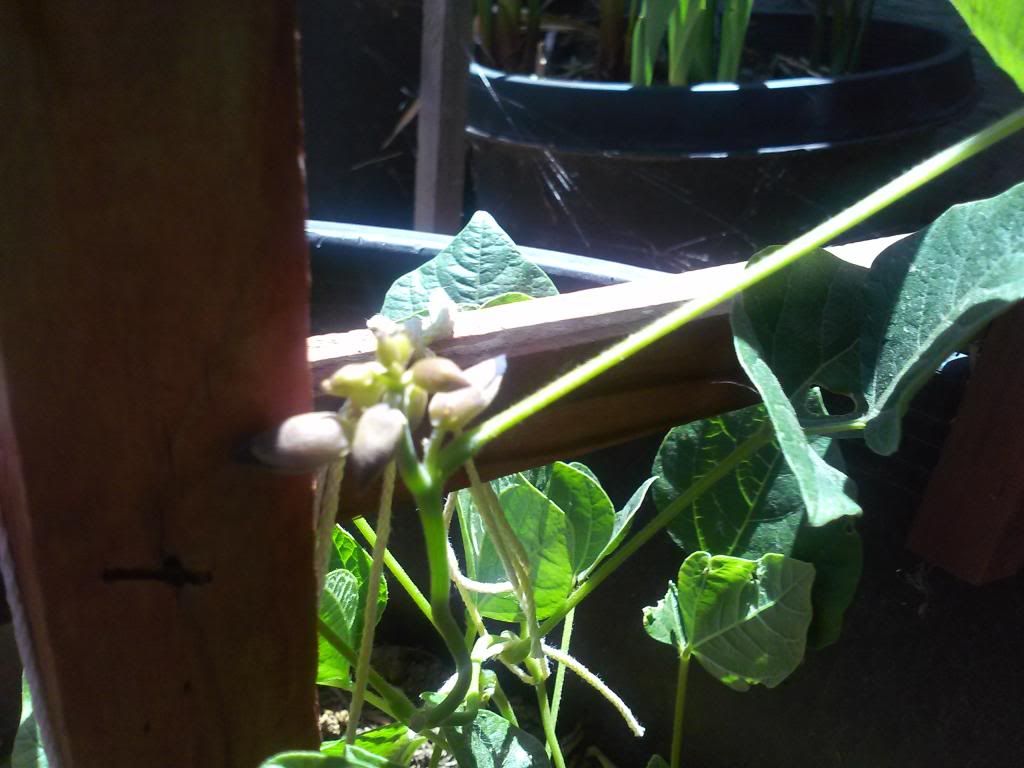|
|
Post by blueadzuki on Aug 15, 2011 21:39:40 GMT -5
This thread is directed mostly at Atash, who I know has experiance with this, but anyone who knows something can chime in.
This year, amoungst the things I planted was a qunatity of Ahipa (Pachyrhizus ahipa). Unlike a lot of other things this year, the Ahipa thrived and now at least one of them is covered with blossoms, possibly more (they're so snarled I am having difficuly telling where one plant ends and another begins, so it is quite possible that more than one plant is in flower, though not all of them.) after a lot of thought, I have decided that, given the shakyness of trying to keep the plants going over the winter, and the relative slowness of tuber growth ahipa is supposed to have, plus the very real likelyhood of cold weather coming early this year (we had a late spring, so an early fall and winter is not at all unlikey) It is better to shoot for seed this year than maxiumum tuber size, so I've decied to let the flowers stay where they are. My questions are primarily two.
1. Is ahipa self pollinating, or does it need insects. I currently have half the plants reflex staked to make the flowers visible (when left at rest the flowers are all completely covered by the leaves) so that and passing insects can see/smell/sense them. However, if ahipa is a self pollinating plant, I would like to know so I can unstake them; being permanently staked against the natural curvature of the plant has got to be stressing them.
2. About how long do the pods get before they are mature? The plants are in a pot with the soil level well below the pots rim (it was orginally full of tomatoes, which tend to benefit from having thier early seedling stages protected from the wind. So I'm a little worried that, as the pods grow, they will hit the sides of the pot and get bed (or worse, break) So I sort of need to know If I have to keep the pods above the level of the pot's rim.
Thank you in advance.
|
|
|
|
Post by atash on Aug 17, 2011 10:30:44 GMT -5
Hello, sorry, I almost overlooked this post. It behaves almost identically to a bush-type common bean (other than the crop is the root not the bean). The flowers must be self-pollinating judging from the fact that although well-colored they are wedged in tight among the leaves and therefor not particularly conspicuous to insects. Mine set pods consistently without intervention, in a greenhouse where insects were sparse. The pods are similar in shape and scale to those of a common bean, on the large end of the scale. If you have enough time left after it makes seed, it might also make a tuberous root similar in shape and size to a turnip. Mine did, but alas rot got into it.  There is a disease in my yard that is hard on anything in Fabaceae. Next time I try it, it will be elsewhere. I ate what wasn't rotted. Very similar in taste and texture to Jicama. |
|
|
|
Post by blueadzuki on Aug 17, 2011 15:35:23 GMT -5
Hello, sorry, I almost overlooked this post. It behaves almost identically to a bush-type common bean (other than the crop is the root not the bean). The flowers must be self-pollinating judging from the fact that although well-colored they are wedged in tight among the leaves and therefor not particularly conspicuous to insects. Mine set pods consistently without intervention, in a greenhouse where insects were sparse. The pods are similar in shape and scale to those of a common bean, on the large end of the scale. If you have enough time left after it makes seed, it might also make a tuberous root similar in shape and size to a turnip. Mine did, but alas rot got into it.  There is a disease in my yard that is hard on anything in Fabaceae. Next time I try it, it will be elsewhere. I ate what wasn't rotted. Very similar in taste and texture to Jicama. Thanks for the info. Yes the flowers are colorful, the sort of remind me of wisteria (except of course in much smaller panicles). And I always planned to take what tuber there was at years end. I was just staing my decision to leave the seed as it stands (some people said that one shoud remove all flowers and pods so the plant had more energy to devote to tuber development. |
|
|
|
Post by Hristo on Aug 17, 2011 17:05:13 GMT -5
|
|
|
|
Post by blueadzuki on Aug 17, 2011 17:25:34 GMT -5
No it would be the same, as I got my seed from the exact same source (It's really the only one I know of, outside of maybe GRIN). if the pods take that long, maybe i shoud plant to take the whole pot inside when it get cold and let them finish up there (like I plan to do to the soy if neccecary.) |
|
|
|
Post by orflo on Aug 18, 2011 4:21:52 GMT -5
Ahipa is indeed a self-pollinator, produces loads of flowers and seed pods and they do take forever to ripen off. I introduced some inoculant last year, and the tubers were bigger, but they were a favourite food of mice and all were hollowed out or eaten. I will try to survive some young plants this winter, and hope that starting these next year will give them an advantage. There should be some shorter-season varieties, but I never did find these. As someone mentioned before, pods must be removed to obtain a decent tuber, plants with lots of seeds forming produce only very thin roots .
|
|
|
|
Post by atash on Aug 19, 2011 0:22:53 GMT -5
Orflo, that is very interesting as lack of suitable innoculant is one of the two show-stoppers for growing this otherwise interesting crop.
What innoculant did you use? Did it take? Where did you get it? I looked all over for an innoculant that would work with Pachyrhizus. None of our native bacteria work.
The other showstopper, as you mentioned, being that tuber production is tied to flowering.
This is a crop that could benefit from some breeding work.
Hristo, I dunno about "varieties" but the plant is variable. The further north you go, the closer the plants are to their wild ancestors, which were short semi-runners. Just like common beans, they got reduced to their current highly determinate "bush" type.
I think maybe it's a bit TOO determinate. You have a ridiculously small plant trying to grow a root the size of a turnip before it goes senescent.
|
|
|
|
Post by orflo on Aug 27, 2011 14:41:24 GMT -5
Atash, it's in fact easy, I asked the ebay guy for some roots with a bit of sand , and the inoculant should certainly be on this. I did get bigger roots, but as I mentioned before, they dissapeared...
|
|
|
|
Post by kevin8715 on May 11, 2014 14:01:20 GMT -5
Bill sent me some to try. Planted in February. Flower buds.  |
|
|
|
Post by billw on May 11, 2014 20:19:32 GMT -5
Well, at least you'll get seed. It will be interesting to see if you get much of a root. That variety is short day for root formation, but you have much less day length variation than we do. From a late May sowing, I got seed in late August and roots in October, but the roots weren't all that impressive.
Orflo recommended removing all the flowers for better root formation, which I am trying this year. I had given up on it as too little result for such a long growing season.
|
|
|
|
Post by kevin8715 on Oct 19, 2014 10:24:23 GMT -5
Well, at least you'll get seed. It will be interesting to see if you get much of a root. That variety is short day for root formation, but you have much less day length variation than we do. From a late May sowing, I got seed in late August and roots in October, but the roots weren't all that impressive. Orflo recommended removing all the flowers for better root formation, which I am trying this year. I had given up on it as too little result for such a long growing season. I hsrvested one that dried up. Slightly bigger tham thumb size. Hopefully next year I can cross it with jicama to get both the slight cold tolerance and large root formation. I still have two plants alive which hopefully overwinter and actually have a harvest that is worthwhile. Maybe the mauka will do better. Seems a whole lot more vigorous anyway. |
|

 There is a disease in my yard that is hard on anything in Fabaceae. Next time I try it, it will be elsewhere.
There is a disease in my yard that is hard on anything in Fabaceae. Next time I try it, it will be elsewhere.

